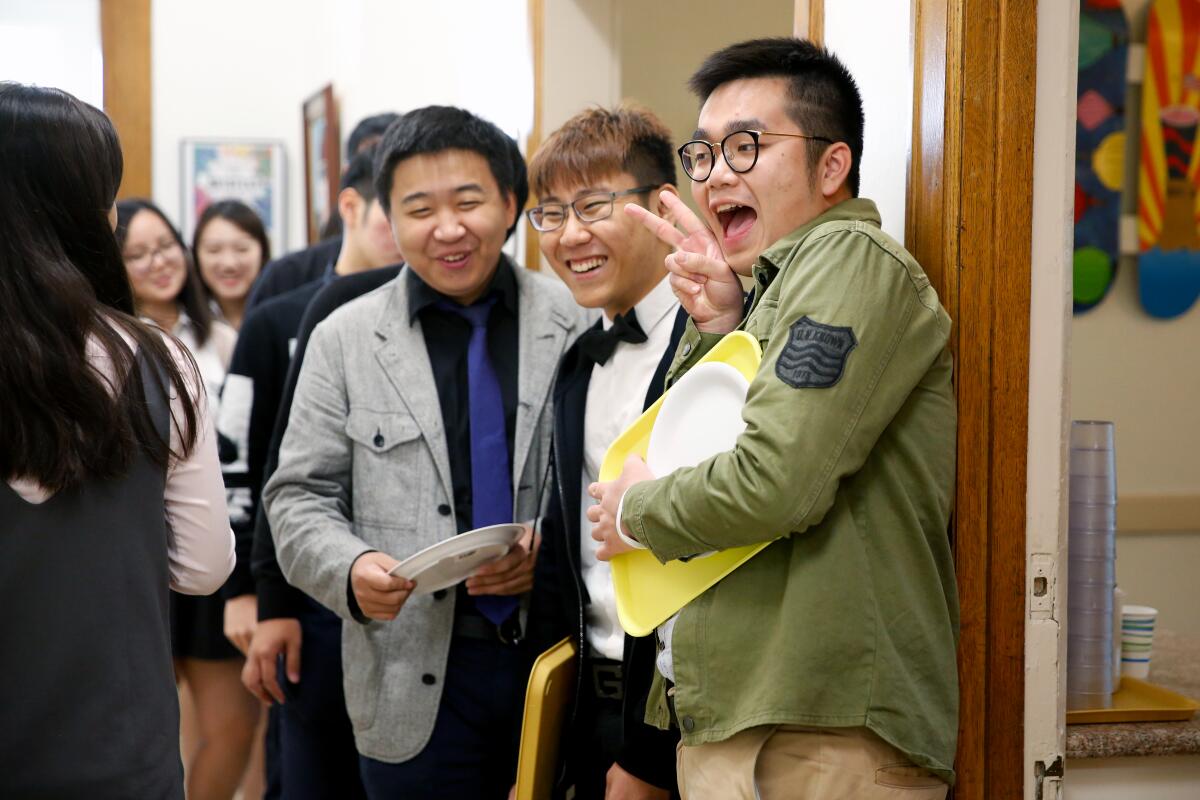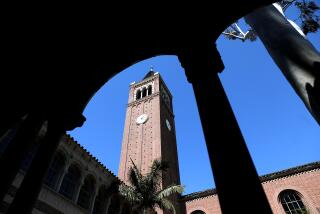California remains the top U.S. destination for foreign students, yet enrollment is slipping

- Share via
California remains the top U.S. destination for foreign students, who primarily come from China and India, with enrollment dipping slightly in the 2018-19 school year for the first time in at least a decade, according to a survey released Monday.
Nationally, new enrollments of international students declined for the third year in a row although overall numbers are at a record high of nearly 1.1 million, according to a survey of 2,800 U.S. colleges and universities released by the Institute of International Education and the U.S. State Department.
The number of students from China, who account for one-third of all international students in the United States, increased by 1.7% while those from India grew by 2.9%.
Some university officials have questioned whether the Trump administration’s harder line on immigration and China is driving international students toward more welcoming environments in other countries.
But U.S. college costs are the single largest concern expressed by prospective foreign students and their families, Allan E. Goodman, the Institute of International Education’s president, said in a recent teleconference to preview the report.
A 2017 survey by the Organisation for Economic Co-operation and Development found that the average U.S. public college tuition was the highest among some 35 member nations surveyed — about $8,200 annually, more than twice as high as the average.
UCLA and UC Berkeley, the leading U.S. public universities, charge about $44,000 annually for foreign students compared with less than $10,000 at their top public counterpart in Japan, Tokyo University.
Caroline Casagrande, deputy assistant secretary of State for academic programs, said new student enrollment began declining in 2015 under the Obama administration and has begun to stabilize. The number of new undergraduates decreased at a slower rate in 2018-19 than in the previous two years while graduate students increased.
“We want even more students in the future to see the United States as the best destination to earn their degrees,” Marie Royce, an assistant secretary of State for educational and cultural affairs, said in a statement. “International exchange makes our colleges and universities more dynamic for all students.”
California continues to attract the most international students — 161,693 — with six of the nation’s top 20 host universities located in the state. USC remained the most popular campus, enrolling 16,340 foreign students in 2018-19, followed by 11,942 at UCLA, 10,652 at UC San Diego, 10,063 at UC Berkeley, 8,064 at UC Irvine and 8,048 at UC Davis.
About 42% of the California foreign students are from China and 12.6% from India. Overall, international students helped boost the state economy by spending an estimated $6.8 billion on tuition, housing, food and other items, the report said.
Some smaller California campuses, such as the University of La Verne, have experienced dramatic declines in Chinese international students over the last few years.
USC and most UC campuses reported continued growth in fall 2019, but are moving to diversify their international students beyond China. India, with its growing economy, enormous population and national network of technical colleges, is a leading target for U.S. universities seeking high-quality graduate students.
USC, for instance, is beefing up offices in Mumbai and Bangalore, doubling staff members from two to four to recruit more Indian students. The university also is looking toward Europe, and opened an office in London two years ago after establishing other centers in Hong Kong, Beijing, Taiwan, South Korea, Brazil and Mexico.
China remains key for USC, which opened a center in Shanghai last year to help Chinese students find jobs after graduating and returning home.
“We do feel like diversification is a good thing,” said Anthony Bailey, USC vice president for strategic and global initiatives. “But we hope to continue to have mainland Chinese students for many, many years to come. With the volume we have and the levels of talent that they have, we don’t think other markets are going to replace China and India. We think there’s more opportunity in both.”
The 10-campus University of California system is moving to recruit more diverse students rather than significantly increase their numbers of foreign students.
Several UC campuses, reeling from major state budget cuts after the 2008 recession, dramatically expanded the number of nonresident students in large part to capture the higher tuition they pay. But that led to a scathing state audit in 2016 accusing UC of hurting California students, prompting the Board of Regents to approve a limit on students from other states and countries the following year.
Overall, even though the UC system admitted fewer freshman applicants from China for fall 2019, a few dozen more accepted their admission offers and were enrolled. But individual campuses varied significantly. At UC Berkeley and UC Irvine, the number of Chinese students increased. But UC Davis saw significant declines, cutting Chinese freshman admissions by 24% and receiving enrollment commitments from 698 students compared with 1,041 the previous fall.
UC San Diego also experienced a slight decrease in undergraduates from China last fall to 1,103 from 1,202 although graduate students increased. The San Diego campus, which enrolls the largest number of Chinese international students in the UC system, has broadened its global outreach in the last two years with first-time visits to Nigeria, Bolivia, Argentina, Turkey and several European countries. India is a key target, and both undergraduate and graduate students from that country increased in fall 2019.
The data come after high-profile cases have emerged in recent months in which students from China and Iran were denied entry into the U.S. by Customs and Border Protection officials, and leading Chinese American scholars have decried what they say is a growing racial profiling of their community by federal agencies that is driving away intellectual talent.
UC San Diego Chancellor Pradeep Khosla said international students will continue to flock to UC campuses because of their quality. But he said smaller colleges and universities might suffer under the Trump administration’s more restrictive immigration policies, and he urged the United States to keep out the welcome mat.
International students expose Americans to global perspectives, he said, and graduate students in particular are vital to the nation’s research enterprise and high-tech workforce.
“If we don’t keep them, Australia wants them. Canada wants them. Europe wants them,” Khosla said. “Talent will find the destination. The question is: Will it be the USA or not?”
More to Read
Sign up for Essential California
The most important California stories and recommendations in your inbox every morning.
You may occasionally receive promotional content from the Los Angeles Times.











